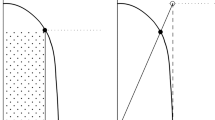Abstract
The USA Bankruptcy Code legislates the bankruptcy of firms. Any allocation mechanism that is legal according to the Bankruptcy Code is necessarily population monotonic. Bankruptcy rules yielding a population monotonic allocation scheme in the associated bankruptcy game are characterized by efficiency, reasonability (each claimant receives a nonnegative amount not exceeding his claim), and the thieve property. The thieve property for bankruptcy problems entails that if a claimant manages to escape with his claim, the amount allocated to each remaining claimant is not larger than his share in the original problem. Many bankruptcy rules studied in the literature are efficient, reasonable, self-consistent, and monotonic. Rules satisfying these axioms are shown to yield population monotonic allocation schemes.
Similar content being viewed by others
References
R.J. Aumann, On the state of the art in game theory, Games and Economic Behavior 24 (1998) 181-210.
R.J. Aumann and M. Maschler, Game theoretic analysis of a bankruptcy problem from the Talmud, Journal of Economic Theory 36 (1985) 195-213.
I.J. Curiel, M. Maschler and S.H. Tijs, Bankruptcy games, Zeitschrift für Operations Research 31 (1988) 143-159.
N. Dagan, New characterizations of old bankruptcy rules, Social Choice and Welfare 13 (1996) 51-59.
M. Maschler, Some tips concerning application of game theory to real problems, in: Game Practice: Contributions from Applied Game Theory, eds. F. Patrone, I. García-Jurado and S. Tijs (Kluwer Academic, Boston, 1999).
B. O'Neill, A problem of rights arbitration from the Talmud, Mathematical Social Sciences 2 (1982) 345-371.
F. Patrone, I. García-Jurado and S. Tijs, eds., Game Practice: Contributions from Applied Game Theory (Kluwer Academic, Boston, 1999).
Y. Sprumont, Population monotonic allocation schemes for cooperative games with transferable utility, Games and Economic Behavior 2 (1990) 378-394.
W. Thomson, Population monotonic allocation rules, in: Social Choice, Welfare and Ethics, eds. W.A. Barnett, H. Moulin, M. Salles and N.J. Schofield (Cambridge University Press, Cambridge, 1995) pp. 79-124.
H.P. Young, On dividing an amount according to individual claims or liabilities, Mathematics of Operations Research 12 (1987) 398-414.
Author information
Authors and Affiliations
Rights and permissions
About this article
Cite this article
Grahn, S., Voorneveld, M. Population Monotonic Allocation Schemes in Bankruptcy Games. Annals of Operations Research 109, 317–329 (2002). https://doi.org/10.1023/A:1016316622277
Issue Date:
DOI: https://doi.org/10.1023/A:1016316622277




